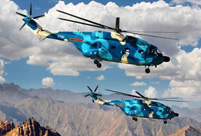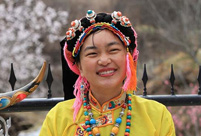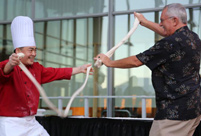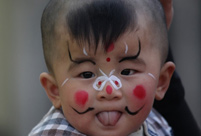 'Model husband' shatters image of love
'Model husband' shatters image of love
 Can animals smile? Or put on a happy face
Can animals smile? Or put on a happy face
 Geng Xuan crowned at 9th China Super Model Contest
Geng Xuan crowned at 9th China Super Model Contest
 Top 10 billionaires in the liquor industry
Top 10 billionaires in the liquor industry
 Backstage at China Fashion Week
Backstage at China Fashion Week
 Ballerinas anywhere but onstage
Ballerinas anywhere but onstage
 Top 10 safest airlines in the world
Top 10 safest airlines in the world
 Posters of 33rd HK Film Awards unveiled
Posters of 33rd HK Film Awards unveiled
 Top 10 most popular instant messaging apps in the world
Top 10 most popular instant messaging apps in the world
 Inspiring shadow images of Chinese army
Inspiring shadow images of Chinese army
Ladies and Gentlemen,
Dear Friends,
Civilizations have become richer and more colorful with exchanges and mutual learning. Such exchanges and mutual learning form an important drive for human progress and global peace and development.
To promote exchanges and mutual learning among civilizations, we must adopt a right approach with some important principles. They, in my view, contain the following:
First, civilizations have come in different colors, and such diversity has made exchanges and mutual learning among civilizations relevant and valuable. Just as the sunlight has seven colors, our world is a place of dazzling colors. A civilization is the collective memory of a country or a nation. Throughout history, mankind have created and developed many colorful civilizations, from earlier days of primitive hunting to the period of agriculture, and from booming industrial revolution to the information society. Together, they present a magnificent genetic map of the exciting march of human civilizations.
"A single flower does not make spring, while one hundred flowers in full blossom bring spring to the garden." If there were only one kind of flower in the world, people will find it boring no matter how beautiful it is. Be it the Chinese civilization, or other civilizations in the world, they are all fruits of human progress.
I have visited the Louvre Museum in France and the Palace Museum in China, both of which house millions of pieces of art treasures. They are attractive because they are able to present the richness of diverse civilizations. Exchanges and mutual learning among civilizations must not be built on the exclusive praise or belittling of one particular civilization. As early as over 2,000 years ago, the Chinese people came to recognize that "it is only natural for things to be different". Greater exchanges and mutual learning among civilizations can further enrich the colors of various civilizations and the cultural life of people, and open up still greater alternatives in the future.
Second, civilizations are equal, and such equality has made exchanges and mutual learning among civilizations possible. All human civilizations are equal in terms of value. They all have their respective strengths and shortcomings. There is no perfect civilization in the world. Nor is there a civilization that is devoid of any merit. No one civilization can be judged superior to another.
I have visited many places in the world. The best thing I wanted to do is to learn about differing civilizations across the five continents, what make them different and unique, how their people think about the world and life and what they hold dear. I have visited Chichen Itza, a window on the ancient Maya civilization, and the Central Asian city of Samarkand, an epitome of the ancient Islamic civilization. It is my keenly-felt conviction that an attitude of equality and modesty is required if one wants to truly understand the various civilizations. Taking a condescending attitude toward a civilization can not help anyone to appreciate its essence but may risk antagonizing it. Both history and reality show that pride and prejudice are two biggest obstacles to exchanges and mutual learning among civilizations.
Third, civilizations are inclusive, and such inclusiveness has given exchanges and mutual learning among civilizations the needed drive to move forward. The ocean is vast for it refuses no rivers. All civilizations are crystallizations of mankind's hard work and wisdom. Every civilization is unique. Copying other civilizations mechanically or blindly is like cutting one's toes just to fit his shoes, which is not only impossible but also highly detrimental. All achievements of civilizations deserve our respect and must be treasured.
History also tells us that only by interacting with and learning from others can a civilization enjoy full vitality. If all civilizations can uphold inclusiveness, the so-called "clash of civilizations" will be out of the question and the harmony of civilizations will become reality. This is like what we Chinese often say, "radish or cabbage, each to his own delight."
Having gone through over 5,000 years of vicissitudes, the Chinese civilization has always kept to its original root. Unique in representing China spiritually, it contains some most profound pursuits of the Chinese nation and provides it with abundant nourishment for existence and development. Though born on the soil of China, it has come to its present form through constant exchanges and mutual learning with other civilizations.
In the 2nd century B.C., China began working on the Silk Road leading to the Western Regions. In 138 B.C. and 119 B.C., Envoy Zhang Qian of the Han Dynasty made two trips to those regions, spreading the Chinese culture there and bringing into China grape, alfalfa, pomegranate, flax, sesame and other products. In the Western Han Dynasty, China's merchant fleets sailed as far as India and Sri Lanka where they traded China's silk for colored glaze, pearls and other products. The Tang Dynasty saw dynamic interactions between China and other countries. According to historical documents, the dynasty exchanged envoys with over 70 countries, and Chang'an, the capital of Tang, bustled with envoys, merchants and students from other countries. Exchanges of such a magnitude helped the spread of the Chinese culture to the rest of the world and the introduction into China of the cultures and products from other countries. In the early 15th century, Zheng He, the famous navigator of China's Ming Dynasty, made seven expeditions to the Western Seas, reaching many Southeast Asian countries and even Kenya on the east coast of Africa. These trips left behind many stories of friendly exchanges between the people of China and countries along the route. In late Ming Dynasty and early Qing Dynasty, the Chinese people began to learn modern science and technology with great zeal, as the European knowledge of astronomy, medicine, mathematics, geometry and geography were being introduced into China, which helped broaden the horizon of the Chinese people. Thereafter, exchanges and mutual learning between the Chinese civilization and other civilizations became more frequent. There were indeed conflicts, frictions, bewilderment and denial in this process. But the more dominant features of the period were learning, digestion, integration and innovation.
Buddhism originated in ancient India. After it was introduced into China, the religion went through an extended period of integrated development with the indigenous Confucianism and Taoism and finally became the Buddhism with Chinese characteristics, thus making a deep impact on the religious belief, philosophy, literature, art, etiquette and customs of the Chinese people. Xuanzang (Hiuen Tsang), the Tang monk who endured untold sufferings as he went on a pilgrimage to the west for Buddhist scriptures, gave full expression to the determination and fortitude of the Chinese people to learn from other cultures. I am sure that you have all heard about the Chinese classics Journey to the West, which was written on the basis of his stories. The Chinese people have enriched Buddhism and developed some special Buddhist thoughts in the light of Chinese culture, and helped it to spread from China to Japan, Korea, Southeast Asia and beyond.
In the course of some two thousand years and more, Buddhism, Islam and Christianity have been introduced into China successively, which allowed the country's music, painting and literature to benefit from the advantages of other civilizations. China's freehand oil painting is an innovative combination of China's traditional painting and the Western oil painting, and the works of Xu Beihong and other masters have been widely acclaimed. China's Four Great Inventions, namely, papermaking, gunpowder, movable-type printing and compass, led to changes in the world, including the European Renaissance. China's philosophy, literature, medicine, silk, porcelain and tea reached the West and became part of people's daily life. The Travels of Marco Polo generated a widespread interest in China.
Many people know about the terracotta warriors, "the buried legions of Emperor Qin". After his visit to the site, President Chirac of France said that a visit to Egypt will not be complete without seeing the pyramids, and that a visit to China will not be complete without seeing the terracotta warriors. In 1987, this national treasure of China, shrouded in secrecy for over two thousand years, was put on the UNESCO World Cultural Heritage list. There are many more proud Chinese achievements that have been included in the World Cultural Heritage list, the World Intangible Cultural Heritage list and the Memory of the World list. Here, I would like to express my heartfelt thanks to UNESCO for its contribution to the preservation and dissemination of the Chinese civilization.


 Wonderful moment of China's airborne forces
Wonderful moment of China's airborne forces Bai Baihe shoots for fashion magazine
Bai Baihe shoots for fashion magazine Red terraced fields in Dongchuan of Yunnan
Red terraced fields in Dongchuan of Yunnan Jiaju Tibetan Village
Jiaju Tibetan Village Spring dating
Spring dating Confucius institute at UC Davis
Confucius institute at UC Davis Little painted faces at temple fair
Little painted faces at temple fair Top 10 safest airlines in the world
Top 10 safest airlines in the world Foreign students at China-Myanmar border
Foreign students at China-Myanmar border The backstage of the Fashion Week
The backstage of the Fashion Week College students in Han costumes
College students in Han costumes Postgraduate works as waitress
Postgraduate works as waitress Life in a Lahu village in Yunnan
Life in a Lahu village in Yunnan An orphan’s wedding
An orphan’s wedding Hollywood documentary brings Diaoyu Islands truth to new audience
Hollywood documentary brings Diaoyu Islands truth to new audienceDay|Week|Month